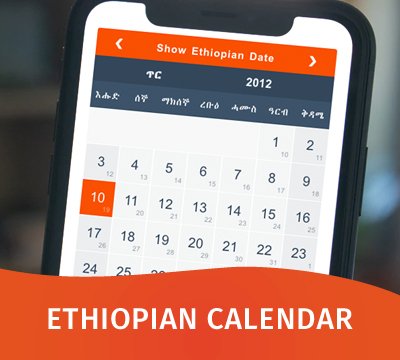Ethiopian Calendar Converter

Ethiopian Calendar
The Ethiopian calendar also known as Ge’ez calendar is the official calendar in Ethiopia. It is also the official calendar of the Ethiopian Orthodox Tewahido Church where it was first adopted. It is a unique and fascinating calendar that has been used in the country for centuries. Unlike the Gregorian calendar, which is based on the solar year and is used by much of the world, the Ethiopian calendar follows a lunar cycle. This calendar was originally developed by the ancient Ethiopians as a way to keep track of the cycles of the moon and the seasons, and it has remained in use to this day. Despite its ancient origins, the Ethiopian calendar is still a vital part of everyday life in the country, shaping everything from religious festivals to business transactions.
Ethiopian Calendar Conversion
The Ethiopia year is seven or eight years behind the current Gregorian year and the country celebrated the millennium on September 11 2007.
Similar to the Coptic calendar, the calendar of Ethiopia has twelve thirty-day months and a thirteenth month with five days or six days in a leap year. Ethiopia is one of the few countries in the world that uses its own calendar today.
The Ethiopian calendar converter above can be used to find out today’s date in Ethiopia. You can convert Ethiopian calendar to Gregorian calendar and vice versa with the Ethiopian date converter by hovering over or clicking on the date. You can also navigate through past and future months and years.
Ethiopian Months
The first Ethiopian month is called Meskerem and starts on September 11 or 12 in a Gregorian leap year. Ethiopian New Year (Enkutatash) is celebrated on Meskerem 1st and is one of the biggest holidays in the country.
Meskel is another huge holiday celebrated on Meskerem 17 or September 27. Meskel is a UNESCO registered celebration and attracts a large number of foreign spectators from around the world. The main event is a called Demera, which means bonfire and Meske Square, in Addis Ababa is one of the locations the celebration is held.
Tiqemet is the second month and begins on October 11. Hedar is the third and begins on November 11. Tahsas is the fourth month and begins on December 11. Ethiopian Christmas (Lidet/Gena) is celebrated on Tahsas 28 or January 7.
Ter is the fifth month and begins on January 10 and Yekatit is the sixth month which begins on February 9. On Yekatit 16, the longest Ethiopian Orthodox fasting period begins which lasts for 56 days. Please see the Ethiopian Orthodox fasting calendar below for more.
Megabit is the seventh month and begins on March 10. Miyazya is the eighth month and begins on April 9. Ethiopia celebrates Easter Sunday (Fasika) on Miyazya 11 (April 19). Fasika is a very popular holiday in Ethiopia, especially to followers of the Ethiopian Orthodox Tewahido Church.
Ginbot is month number nine and begins on May 9. Sene is the tenth month and begins on June 8. Hamle is month number eleven and starts on July 8. Nehase is month number twelve and begins on August 7.
Pagume is the thirteenth and last month in calendar of Ethiopia and begins on September 6.
Ethiopian Days
Monday is called Segno, Tuesday is Maksegno, Wednesday is Erob/Rabue, Thursday is Hamus, Friday is Arb, Saturday is Kidame and Sunday is called Ehud.
Ethiopian Orthodox fasting dates
There are seven fasts in the Ethiopian Orthodox Tewahedo church when followers do not consume meat and dairy products. During fasting periods, churches hold morning services of prayer and hymns of forgiveness. On fasting days, first meals are eaten after 3PM. Find out more about about the Ethiopian fasting calendar.
